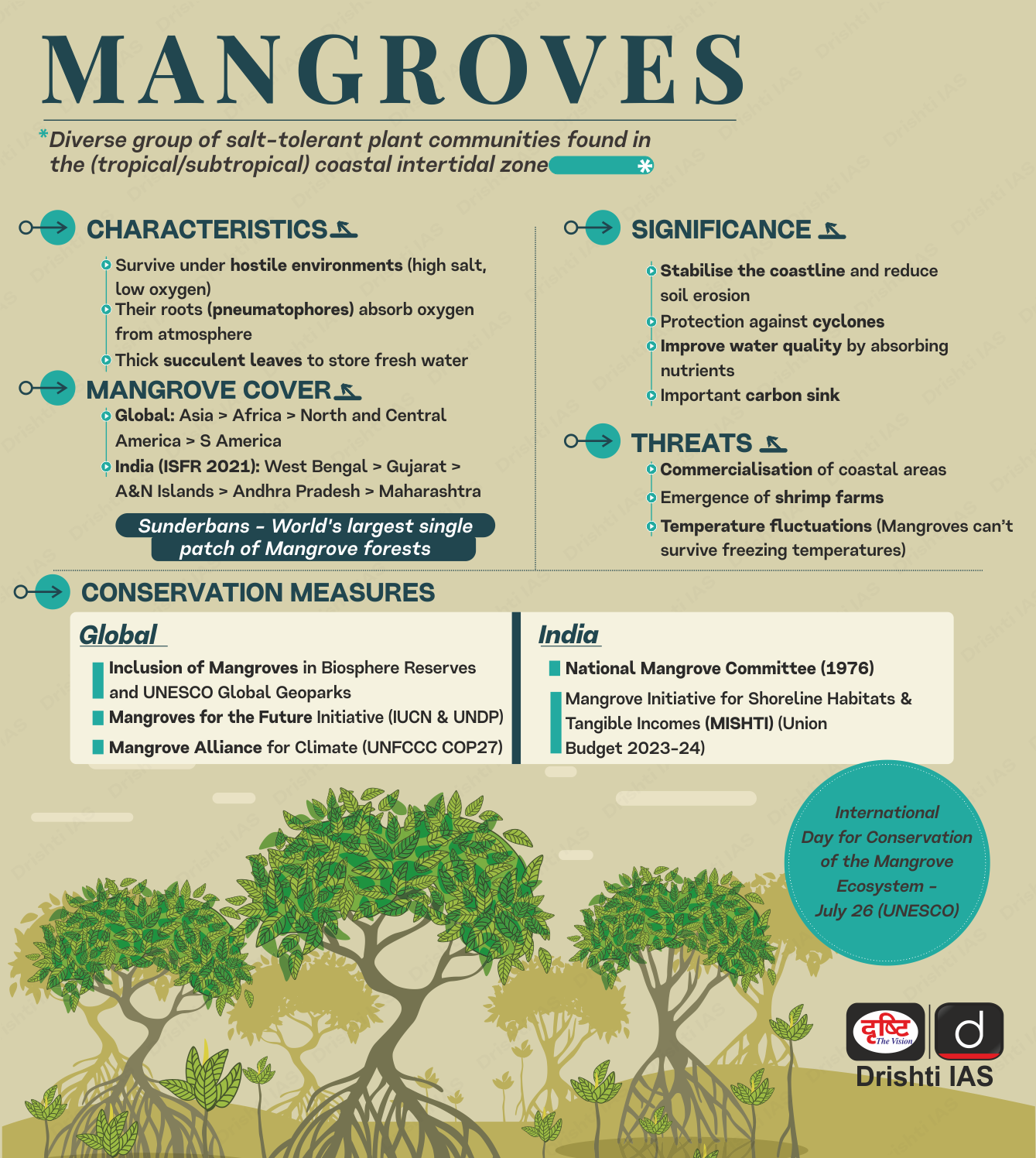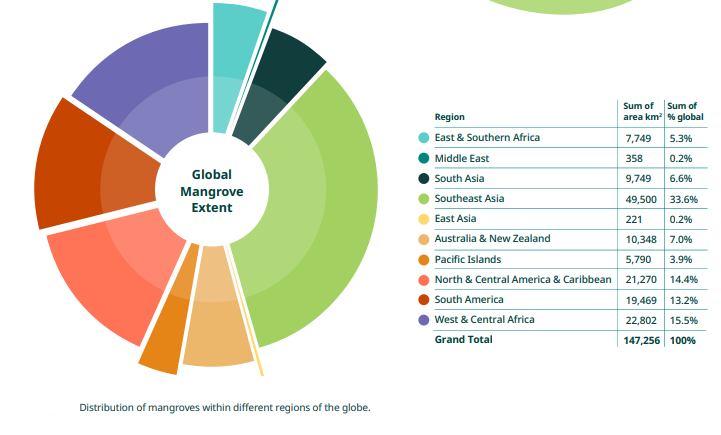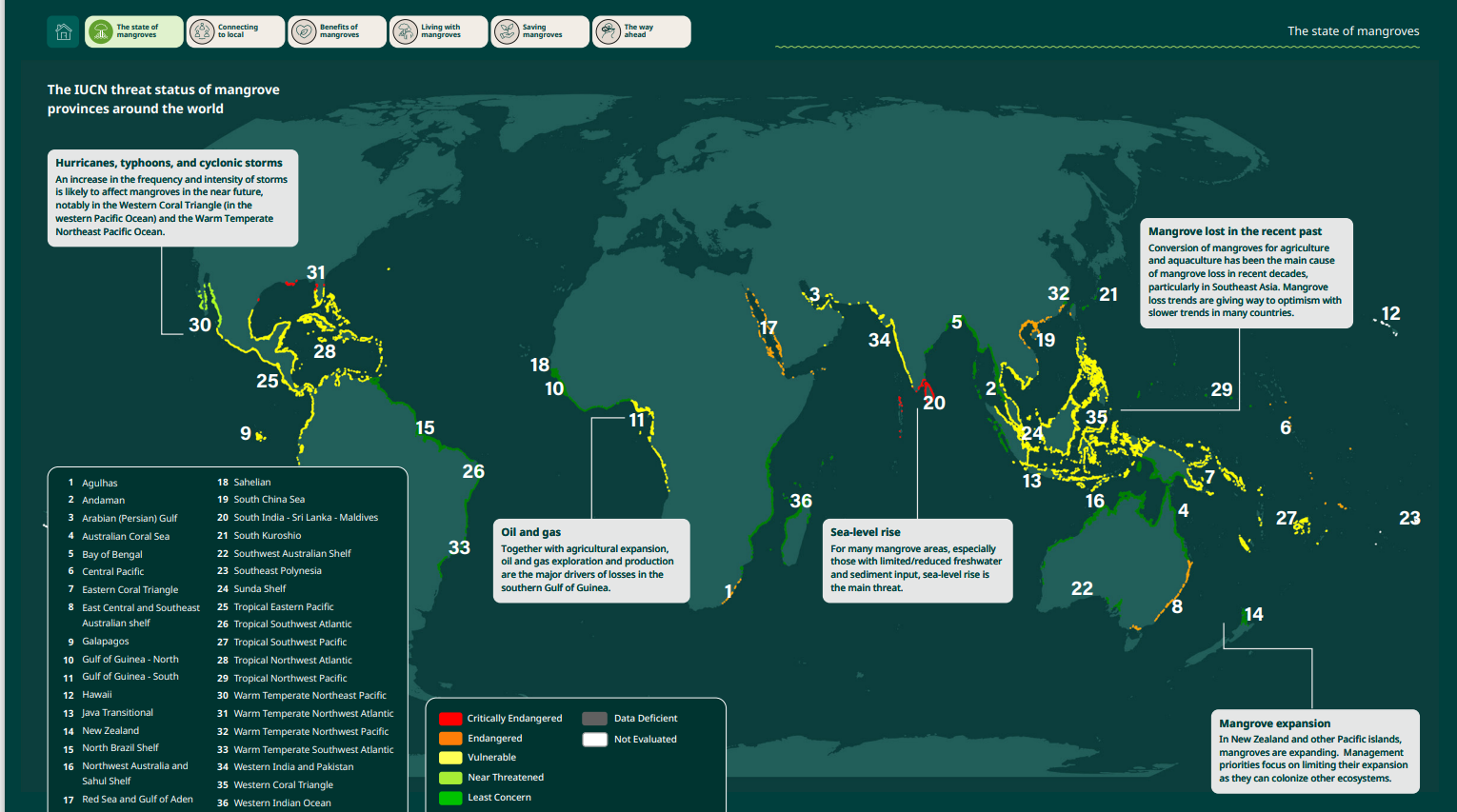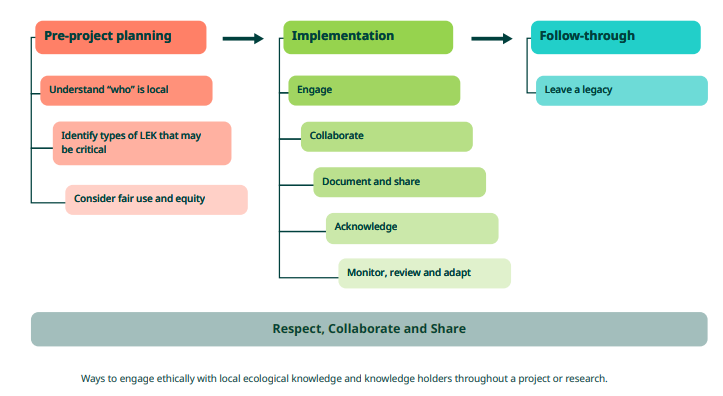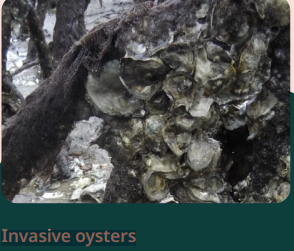Biodiversity & Environment
The State of Mangroves 2024
- 12 Aug 2024
- 47 min read
For Prelims: State of the World's Mangroves 2024, Global Mangrove Alliance, World Mangrove Day, Global Mangrove Watch, Aquaculture, Sea-level rise, IUCN Red List, Ecosystem services, Carbon storage, Ecotourism, Kunming-Montreal Global Biodiversity Framework
For Mains: Challenges to Mangroves, Status of Mangroves
Why in News?
Recently, a report titled "The State of the World's Mangroves 2024" was released by the Global Mangrove Alliance (GMA) on World Mangrove Day (26 July).
- The GMA is the preeminent alliance of 100-plus members driving the conservation and restoration of the world’s mangroves.
What is the State of Mangroves?
- The World of Mangroves:
- Data on the location and spatial extent of mangroves is crucial for the protection and conservation of mangrove forests. The first global maps of mangrove forests were generated in 1997, and again in 2010 and 2011. These were one-off maps that had not been updated.
- Since 2018, the Global Mangrove Watch (GMW) has provided a time series of global mangrove extent maps from 1996 to 2020. The GMW mangrove extent dataset is now in its fourth iteration, with the GMW v4.0 released in 2024.
- The GMW v4.0 2020 mangrove extent mapped 147,256 km2 of mangroves globally. This total extent is very similar to that mapped in GMW v3.0, but includes more notable changes at higher resolutions.
- The overall accuracy of the GMW v4.0 map was estimated at 95.3%, a considerable improvement on GMW v3.05.
- The enhanced accuracy can be attributed to some factors, including improvements in the GMW mangrove habitat mask, better satellite imagery at higher spatial resolution, better and more accurate training data, and improvements in the machine learning approach to the classification.
- Future work with GMW v4.0 will include a re-mapping of the historical time series, enabling a more reliable assessment of change over time.
- The GMW v4.0 map has identified mangroves in 128 countries and territories, six more than in the previous GMW v3.0 map.
- St. George’s Island in Bermuda holds the northernmost record for naturally occurring mangroves at latitude 32.36°, while the southernmost mangroves, now extended 5 km further south to latitude 38.90° in Victoria, Australia.
- The Diversity of Mangroves:
- Mangrove plants, which thrive in tropical and subtropical coastal environments, display diverse specialized adaptations, but the current global list of mangrove-specific species is subjective and incomplete, necessitating an updated authoritative list despite significant challenges.
- There are no clear criteria for defining a plant as a mangrove, with debate on whether a plant is specific to mangroves or just an associate.
- Tidal marsh plants often coexist with mangroves, complicating the distinction between mangrove and tidal marsh species.
- Newly described species and subspecies indicate our incomplete understanding of mangrove biodiversity.
- Taxonomic questions about hybrid species in three genera impact their classification and inclusion in the IUCN Red List process.
- Some of the distinctive attributes associated with many mangrove species include: exposed above-ground breathing roots; extra trunk support structures; salt-excreting leaves; low water potentials and high intracellular salt concentrations for maintaining favourable water relations in saline environments; and viviparous, water-dispersed propagules grown while attached to the parent plant.
- The IUCN Mangrove Specialist Group (MSG) is working to finalize an authoritative list of mangrove species, using their expertise in biogeography and taxonomy, with updates to be reflected on their website.
- Mangrove plants, which thrive in tropical and subtropical coastal environments, display diverse specialized adaptations, but the current global list of mangrove-specific species is subjective and incomplete, necessitating an updated authoritative list despite significant challenges.
- Adjacent Ecosystems:
- Defining and mapping the complex mosaic of coastal ecosystems, including mangroves, tidal marshes, seagrass meadows, tidal flats, and coral reefs, is challenging but improving with open-access remote sensing imagery and advanced computing platforms.
- Tidal Marshes: The 2023 global tidal marsh map, based on 10-meter resolution Sentinel imagery, shows a 2020 extent of 52,880 km², primarily in temperate and Arctic regions, but also identifies over 7,000 km² in tropical areas, often behind mangroves.
- Seagrass: Efforts like the Caribbean Carbon Accounting in Seagrass (CariCAS) network are improving our understanding of seagrass extent and carbon stocks, highlighting their significant role in climate change mitigation despite global uncertainties in seagrass mapping.
- Other Ecosystems: Coral reefs, mapped globally by the Allen Coral Atlas, and tidal flats, crucial for carbon storage and storm protection, face threats from human activities, highlighting the need for holistic conservation efforts that consider the interconnectedness of mangroves and adjacent ecosystems.
- Defining and mapping the complex mosaic of coastal ecosystems, including mangroves, tidal marshes, seagrass meadows, tidal flats, and coral reefs, is challenging but improving with open-access remote sensing imagery and advanced computing platforms.
What are the Drivers of Change to the World’s Mangroves During 2000-2020?
- Food and Agriculture Organization of the United Nations (FAO) Study: The Food and Agriculture Organization of the United Nations (FAO) recently conducted an extensive study on the global status of mangroves.
- This study utilized a novel methodology that integrated remote sensing technology with local knowledge to analyze mangrove area changes.
- The conversion of mangroves for aquaculture, oil palm plantations, and rice cultivation accounted for 43.3% of global mangrove loss between 2000 and 2020.
- The study highlights "natural retraction," caused by shifts in riverbeds, sediment inputs, or sea levels, as responsible for 26% of mangrove loss over the past 20 years.
- Taking a broader categorization, natural causes predominate in South America and Oceania, while human-induced drivers are overwhelmingly dominant in Africa and Asia.
- Natural expansion comprised 82% of all gains globally. Nonetheless, restoration efforts were also recorded and accounted for 25% and 33% of mangrove expansion in South and Southeast Asia and Africa, respectively.
- Contrary to expectations, the study found that natural expansion of mangroves far outpaced natural retraction, highlighting their resilience and the complex interplay between local biophysical conditions and global warming impacts.
- The Red List of Mangrove Ecosystems:
- The International Union for Conservation of Nature (IUCN) has led a global study involving more than 250 scientists from 44 countries entitled the Global Red List of Mangrove Ecosystems.
- The study started by classifying the world’s mangrove ecosystems in 36 provinces and piloted the Red List of Ecosystems (RLE) methodology in the Southeast Asia region. This same approach was then applied in the first global assessment of mangroves using the RLE methodology.
- 18 mangrove provinces, representing about 50% of the world's mangrove area, are threatened, with eight provinces classified as Endangered (EN) or Critically Endangered (CR).
- Climate change, particularly severe cyclonic storms and sea-level rise, threatens one-third (30%) of the assessed mangrove provinces, affecting 37% of the global mangrove area.
- Past losses have put 28% of mangrove provinces (38% of the global area) at risk. While mangrove conversion is slowing in South and Southeast Asia, it is accelerating in regions like the Gulf of Guinea South province.
- The RLE global study can help guide national assessments and actions to mitigate mangrove loss, but countries should prioritize reliable national or lower-scale assessments for decision-making.
- Management strategies for achieving global commitments, such as the Mangrove Breakthrough to secure 150,000 km² of mangroves, should consider the risk of collapse due to climate change, with the Global Red List of Mangrove Ecosystems contributing to these global goals.
|
What is the Role of Local Communities in Conserving Mangroves?
- Engaging with Local Ecological Knowledge (LEK) in Research and Practice:
- Local ecological knowledge (LEK) can provide vital information to develop mangrove conservation and restoration efforts with greater potential for long-term outcomes.
- The Global Mangrove Alliance's LEK Best-Practice Guide provides comprehensive guidance for ethically and effectively incorporating Local Ecological Knowledge (LEK) into mangrove research and conservation projects.
- Raising awareness of the variety and scope of LEK about mangrove ecosystems.
- Highlighting the value that LEK can bring to mangrove conservation and restoration.
- Encouraging increased engagement of LEK in projects.
- Emphasizing the importance of equitable collaboration.
|
- Diversified Livelihoods For Mangrove Communities:
- A key component of ongoing mangrove management is the need to ensure local communities can be engaged in a sustainable manner, benefiting from mangroves.
- In places where growing populations and diminished mangroves coincide, opportunities for increasing the sustainability of traditional or modern practices may be required, as well as new opportunities, within or beyond the mangroves.
- Fisheries:Mangroves can be thought of as ‘fish factories’, generating very large quantities of commercially important species.
- Salt Production: Salt production is often undertaken in close proximity to mangrove forests and can have highly negative impacts including the clearance of mangroves to make salt pans or associated infrastructure, but also the unsustainable approach of cutting the mangroves for firewood to crystalize the salt by heating brine over fire.
- Both of these impacts can be reduced, by restricting salt production to non-mangrove areas, and by halting the use of mangrove firewood.
- One such example is in Guinea, where 30% of the mangrove salt is now produced by allowing natural evaporation of brine.
- Sustainable Timber Harvesting: The export of mangrove wood has been documented as far back as 1,200 years ago. Mangrove wood is durable, and its resistance to termites makes it an attractive building material.
- Communities that still depend on mangrove wood have developed harvesting techniques that retain the valuable ecosystem services of the forests.
- Beekeeping: In parts of Mexico and South America, the traditional practice of beekeeping is regaining popularity as a way for communities to gain supplemental income and, in turn, they are assisting the survival of native stingless bees that have been severely impacted by invasive Africanized honeybees.
- Management, Restoration, Research: In Ecuador, community members from the Sabana Grande Association have a mangrove nursery in which they grew seedlings to restore an abandoned shrimp pond.
- The success of their nursery led to additional income when nearby communities purchased seedlings for their own mangrove restoration events to commemorate the International Day for the Conservation of the Mangrove Ecosystem.
- Tourism and Recreation: Tourism and recreation activities are widely undertaken within mangroves, both by local communities and visitors.
- Recreational fishing, including fly-fishing in mangrove adjacent shallow ”flats”, can be particularly popular. In countries such as the Bahamas, Cuba, and Belize, the best local fishing guides are highly sought-after by international fishers.
- Connecting Across Scales:
- Global models and datasets have been critical in understanding the dynamics of mangrove ecosystems, from mangrove cover and fisheries production to carbon stocks.
- In turn, these global products are key toolsets in driving international policies, strategies and targets. For example, under the Sustainable Development Goals, the Paris Agreement, the Convention on Biological Diversity, as well as the protection and restoration strategies of the GMA.
- Enhancing global analyses with field-based inputs improves model accuracy, supports standardization, and aids national strategies for mangrove conservation and restoration, fostering engagement and collaboration among local researchers and stakeholders.
- The potential of citizen science initiatives has proven to be revolutionary in areas of biodiversity monitoring (e.g. iNaturalist)
|
What are the Benefits of Mangroves?
- Mangrove Blue Carbon:
- The new 2023 global model, supported by the Global Mangrove Alliance, shows that mangrove soils and biomass store significant carbon, with most of it in the top meter of soil, highlighting their role in carbon sequestration and emissions mitigation.
- Mangroves store an average of 394 tonnes of carbon per hectare. Of this figure, 319 tonnes are in soil, 54 tons are in above ground biomass, and 21 tonnes are in belowground biomass.
- Mangroves in southeast Asia (e.g., in Sumatra and Borneo, Indonesia, Malaysia, and Myanmar) have the largest stocks of blue carbon.
- However, significant stocks were also found within west Africa (e.g., in Nigeria and Guinea-Bissau), Central and South America (e.g., in Mexico, Venezuela, and Colombia) and the Caribbean (e.g., in Cuba).
- Biodiversity in Global Mangrove Ecosystems:
- Mangrove ecosystems are biologically diverse, due to the diversity of conditions and niches they contain, including forest structures, litter-dominated forest floors, mudflats, and water bodies.
- Located between land and sea, mangrove ecosystems support both terrestrial and aquatic organisms.
- They serve as the nursery, feeding, and breeding grounds for crabs, prawns, mollusks, finfish, birds, reptiles, and mammals.
- Mangroves also possess a variety of microorganisms, making the habitat nutrient-rich and productive.
- Insect diversity in mangroves is particularly high even when plant diversity is low. More than 3,000 insect species have been recorded in Singapore’s mangroves alone.
- The Sundarbans in India and Bangladesh provide a “home” for globally threatened species including tigers, fishing cats, Gangetic dolphins, estuarine crocodiles, horseshoe crabs, water monitor lizards, and river terrapins.
- Mangrove ecosystems of India have perhaps the highest record of biodiversity of any country, with a total of 5,746 species. Of these, 4,822 species (84%) are animals. They include most of the major taxonomic groups of animals, with 21 recorded phyla, and makeup 4.76% of Indian fauna.
- Twelve species groups dominate the numbers. These include mangrove plants and their associates, marine algae (phytoplankton and seaweeds), fungi, protozoa, nematodes, polychaetes, arachnids, crustaceans, mollusks, insects, birds, and finfish.
- Despite their importance, however, the actual species richness of different mangrove regions in the world remains poorly documented due to the lack of systematic and extensive field surveys.
- Little is known about the effects of mangrove loss on biodiversity at local or regional scales.
- The current IUCN Red List of Threatened Ecosystems describes eleven of the 70 mangrove species (16%) as being at an elevated threat of extinction, especially those on the Atlantic and Pacific coasts of Central America.
- Worldwide, a significant number of species are endemic to mangroves, including 48 birds, 14 reptiles, one amphibian, and six mammals, mostly in Asia and Australia. Some 40% of these are threatened with extinction.
|
- Mangroves’ Interaction With Incoming Coastal Stormwaters:
- Flooding is the most frequently occurring natural disaster. According to the results of global studies, approximately 1.3% of the global population lives in areas that are exposed to 1-in-100-year coastal flood events.
- Mangroves affect patterns of coastal flooding by slowing down and redirecting storm surges and attenuating wind and swell waves.
- Mangroves cannot completely block high water levels that are generated during a storm surge, but they do lower propagation speeds, inundation depths, and overall flood extents.
- Mangroves typically lower flood depths by 15-20% with maxima exceeding 70% for storms with a return period of 100 years in the current climate.
- Scientific studies show that while large mangrove green belts significantly reduce coastal flooding, even smaller patches can lower flood depths and diminish wave impact in adjacent areas.
- The effectiveness of mangroves’ capacity to mitigate coastal flooding depends on various factors like the forest’s characteristics (width and vegetation density), coastal topography, and storm conditions (e.g. storm surge height, storm duration).
- Mapping the global flood risk reduction value of mangroves: Computer models simulate mangroves' impact on storm surges by treating them as rough, friction-generating surfaces, but the transect approach used in global studies is less effective for complex coastal settings like estuaries, deltas, and lagoons.
How Mangroves are Related to Food Security?
- Food Security and Mangroves:
- Mangroves are among the world’s most productive ecosystems, their high productivity sustaining a rich food web, providing food, fiber, and fuels alongside cultural services that help maintain human wellbeing. They support all four dimensions of food security.
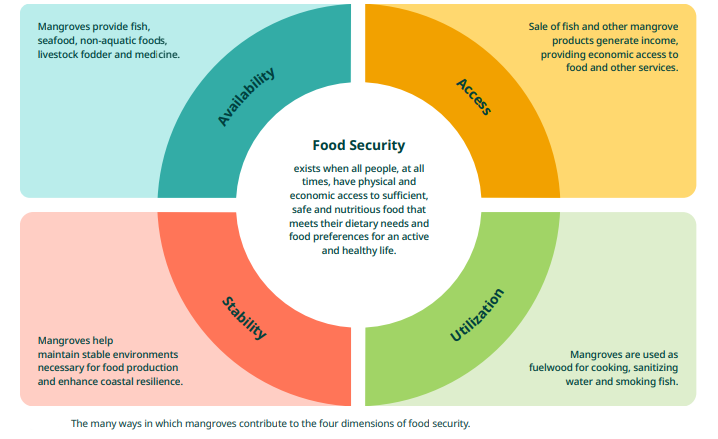
- Mangrove Fisheries: Fish and seafood sourced from mangrove ecosystems are often rich in essential nutrients, such as protein, omega-3 fatty acids, vitamins (e.g., vitamins D and B12), and minerals (e.g., iron, zinc).
- A global group of nearly 50 mangrove fisheries scientists have developed a model to estimate the density and abundance of commercially important fish and invertebrates that are known to use mangroves extensively.
- Field data on the density of 37 species was found from locations around the world, including species of fish, prawns, crabs, and one cockle species.
- Across the 37 species it is estimated that the presence of mangroves annually supports nearly 800 billion young-of-year fishes, prawns and bivalves, and adult crabs.
- Non-Aquatic Foods: Mangrove ecosystems also offer a variety of nonaquatic food resources. For example, leaves of some mangroves and herbs found in mangrove habitats are collected and consumed as vegetables.
- Mangroves as fodder for Livestock: Mangroves are directly consumed, not only by humans but also by livestock. Mangrove leaves serve as fodder for livestock, such as goats, sheep, cows, and camels, particularly in drier regions.
- Fuelwood and Charcoal: Mangroves are a source of fuelwood that is used by coastal communities for cooking, sanitizing water, and smoking fish.
- Source of Income: The sale of products derived from mangrove ecosystems, including fish and other aquatic species, timber, charcoal, honey, fruits, vegetables, and other non-wood forest products, also helps to confer economic stability for coastal communities.
- Stability and Resilience: Finally, mangroves provide other critical ecosystem services that underpin food production and provide stability over time.
- Mangroves are among the world’s most productive ecosystems, their high productivity sustaining a rich food web, providing food, fiber, and fuels alongside cultural services that help maintain human wellbeing. They support all four dimensions of food security.
|
- Aquaculture and Mangroves:
- The Problems With Aquaculture for Mangroves:
- Ancient forms of aquaculture have been practiced for over 2,000 years. The gei wais of Hong Kong and the tambaks of Indonesia are traditional forms of aquaculture that still exist today. However, these bear little resemblance to modern industrial aquaculture.
- The current best estimates of shrimp aquaculture globally are some 3.49 million hectares.
- Attempts at solutions:
- Certification and ecolabeling of shrimp from low-impact or mangrove-friendly aquaculture have proven ineffective, with significant issues still persisting, as shown by independent studies in Honduras and Bangladesh.
- Many newly created jobs, such as security guards or shrimp processors, are low-paid and low-skilled.
- Mangrove conservation and restoration opportunities, developed with local communities, provide a better alternative to shrimp certification or “mangrove-friendly” aquaculture.
- The Problems With Aquaculture for Mangroves:
- Restoring Mangroves by Growing Food:
- The expansion of aquaculture has led to mangrove destruction, but intensive farming in mangrove habitats is often unsuccessful, leaving degraded zones that could be restored for sustainable, input-free seafood harvesting.
- Integrated mangrove aquaculture (IMA) involves the restoration of mangroves within ponds and embankments of farms.
- Once established, the mangroves provide both food and shelter for aquatic species to grow and thrive as part of the natural food web. IMA usually involves a polyculture approach where farmers grow multiple species of shrimp, crab, filter-feeding fish, and bivalve mollusks.
- IMA is the aquatic version of agroforestry on land, where food is grown and harvested within a functional ecosystem.
- IMA ideally involves the restoration of at least 50% of the total surface of a given farm with mangroves.
- IMA offers robust income opportunities for local communities. After the cost of hatchery-reared juveniles, there are no further expenses. Thus, the debt trap common to many small-scale intensive shrimp farmers, linked to costs for feed, fertilizers, or other chemicals, can be avoided.
|
What are the Need & Steps in Direction of Saving Mangroves?
- Need For Protection:
- Given mangroves’ immense value, both to biodiversity and to people, the logic of protecting mangroves is almost unassailable, and hence the call from the Global Mangrove Alliance (GMA) to double protection by 2030.
- At the same time, this is no small challenge. Some 40% of the world’s remaining mangrove forests are already represented in protected areas. Doubling this to 80%, especially when so many threats remain, will require immense effort.
- Existing mangrove-protected areas include iconic places such as the Florida Everglades National Park in the U.S.A. and the Daintree National Park in Australia.
- Urban protected areas give popular access to mangroves in towns and cities, for example in the UAE, Dubai, Singapore, and China.
- Important and spectacular biodiversity is secured, including Bengal tigers in the Sundarbans World Heritage Site, and over 20,000 flamingos living in the Mexican Biosphere Reserves of Los Petenes and Ría Celestún.
- Some of the major mangrove nations, such as Brazil, Mexico, and Bangladesh, have already declared over three-quarters of their mangroves as protected.
- For these countries, doubling protected areas coverage is not possible, although the effectiveness of protection is always important to monitor.
- At the other end of the spectrum, many countries still fall below 5% protection, including Malaysia, Papua New Guinea, and Myanmar.
- Even Indonesia, which still hosts a fifth of the world’s mangroves despite extensive losses, has only placed 15% of what remains within protected areas.
- Other Effective Area-based Conservation Measures(OECMs):
- Alongside protected areas, there is now widespread recognition that conservation can also be achieved by other means.
- OECM embraces a host of potential locations and situations outside of protected areas where human impacts or activities may be restricted, or where sustainable uses may be recognized and secured over the long term.
- They generate effective and secure conservation outcomes equal to, and often complementary to, formally designated protected areas.
- Existing guidelines point out that OECMs need to have a clear geographic definition and contain areas of biodiversity interest.
- They may fall under public, private, or traditional ownership, or a combination of these. As with protected areas, their governance must be equitable and effective.
- Alongside protected areas, there is now widespread recognition that conservation can also be achieved by other means.
- Alerts For Action:
- Mangrove losses typically occur over short time periods. Yet in annual mangrove extent maps, such as the Global Mangrove Watch (GMW) extent layers, information only changes a year or more after a loss occurs.
- The recognition that a quicker way of identifying mangrove loss is imperative led to the development of the GMW mangrove loss alerts product.
- The GMW mangrove loss alert system was implemented using the Microsoft Planetary Computer, which provides a cloud computing environment for the analysis of satellite imagery.
- Restoration:
- Mangrove restoration is receiving increased attention fueled by national and international targets. From the Bonn Challenge to GMA’s target of restoring just over 4,000 km2 by 2030, ambitious goals are catalyzing collective action across science, policy, and practice.
- New tools, resources, and training programs are helping to improve mangrove restoration and conservation, and efforts on the ground are increasing worldwide.
- Restoration requires capacity-building and dedicated efforts to match restoration opportunities with funding and investors.
- Global tools like the Mangrove Restoration Tracker Tool have been developed to encourage adequate reporting and monitoring, and to facilitate the sharing of experiences and best practices globally.
- Restoration guidance In October 2023:
- The GMA and the Blue Carbon Initiative developed the Best Practice Guidelines for Mangrove Restoration. The Guidelines were developed to provide project managers, investors, and policymakers with a step-by-step approach for every phase of the project cycle, from project design and funding to implementation.
- It focuses on inclusive, community-based approaches which have been shown to enhance restoration success and longevity.
- They are broken down into four core sections:
- Phase 1 provides guidance on how to set goals and assess the suitability of the project.
- Phase 2 guides on project design, specifically how to understand socio-economic and biophysical factors.
- Phase 3 dives into the practicalities of project implementation and funding, and how to engage stakeholders and measure progress.
- Phase 4 offers guidance on monitoring, evaluation and adaptive management.
- They are broken down into four core sections:
- Six Guiding Principles For Successful Mangrove Restoration: To ensure a holistic vision of mangrove restoration, the GMA partners, scientists, and practitioners developed six guiding principles that serve as guardrails for successful mangrove restoration and can be applied in every phase of the project cycle.
- Principle 1-Safeguard nature and maximize biodiversity:
- Protect the remaining intact mangrove ecosystems, enhance their resilience, and implement science-based ecological restoration protocols.
- Principle 2-Employ the best information and practices:
- Use the best available science-based knowledge, including Indigenous, traditional, and local knowledge, for mangrove interventions.
- Principle 3-Empower people and address their needs:
- Implement, in all aspects of project design, social safeguards that operate locally and contextually to protect and enhance community member rights, knowledge, and leadership to achieve fair and equitable benefit sharing.
- Principle 4-Align to the broader context:
- Operate in the local context, including cultural customs, resource use, management, and ownership regimes, while taking a land and seascape approach and aligning to international trends and their local implications.
- Principle 5-Design for sustainability:
- Create sustainable mangrove projects and programs that are inclusive of how these initiatives will last into the future, including considerations for financing, threat abatement, community stewardship, and climate change.
- Principle 6-Mobilize high-integrity capital:
- Ensure capital flows at the scale needed and allow funding to be distributed to ready-to-scale projects.
- Principle 1-Safeguard nature and maximize biodiversity:
- The Community-Based Ecological Mangrove Restoration (CBEMR) method: The Community-Based Ecological Mangrove Restoration (CBEMR) method, pioneered by the Mangrove Action Project (MAP), represents an innovative approach to mangrove restoration that has garnered global recognition for its efficacy and sustainability.
- Employ the best information and practices
- Empower people and address their needs
- Safeguard nature
- Align to the broader context – operate locally and contextually
- Design for sustainability
- Mobilize high-integrity capital
- Tools For Informing Global Policy Commitments:
- Policies:
- Current Status: As of 2023, 61 countries have incorporated mangrove action in their national climate commitments, as indicated by a 2023 analysis by the Ocean and Climate Platform, Conservation International, IUCN, Rare, The Nature Conservancy, Wetlands International and WWF.
- Similarly, 50 governments have also endorsed the Mangrove Breakthrough (including Mangrove Alliance for Climate’s countries), committing to secure the future of 15 million hectares of mangroves and accelerating towards effective implementation of mangrove action on the ground by 2030.
- 2030 Targets: Under the UN Decade on Ecosystem Restoration and the Kunming-Montreal Global Biodiversity Framework (GBF) (2022) countries pledge to “ensure that by 2030 at least 30% of areas of degraded terrestrial, inland water, and marine and coastal ecosystems are under effective restoration”.
- International Developments For Mangrove Action:
- The UAE Consensus: At the 2023 UNFCCC’s COP28 in Dubai, countries adopted a landmark agreement to transition away from fossil fuels, a historic (and long-overdue) accomplishment after 28 years of UNFCCC convenings, and eight years since the signing of the Paris Agreement. Countries also called for complementary climate action on nature, oceans, and food systems.
- The Kunming-Montreal Global Biodiversity Framework: In 2022, the CBD adopted the landmark Kunming-Montreal Global Biodiversity Framework (GBF), which serves as a global action plan for biodiversity and provides the mandate for countries to halt and reverse biodiversity loss by 2030.
- The Ocean Breakthroughs, led by the Marrakech Partnership for Global Climate Action (MPGCA), have set the Aquatic Food target to provide USD 4 billion annually by 2030 to support resilient aquatic food systems.
- The FAO’s 2024 update of the small-Scale Fisheries Guidance emphasizes the importance of maintaining, restoring, and enhancing local ecosystems, especially mangroves, for coastal fisheries and livelihoods.
- At COP28, 159 countries signed the Emirates Declaration on Sustainable Agriculture, Resilient Food Systems and Climate Action, committing to scale up adaptation and resilience for farmers, fishers, and food producers by promoting sustainable practices that boost productivity, protect land and natural ecosystems, and support sustainable aquatic blue foods.
- Future Outlook: Mangroves at the 2025 UN Climate Change Conference: The 2025 UN Climate Change Conference (UNFCCC COP30) will convene in November 2025 in Brazil, with nature and IPLCs (Indigenous peoples and local communities) high on the agenda.
- The GMA, with partners of the Mangrove Breakthrough, plans to promote the key role of mangroves for climate action at COP30 by leveraging its expansive network and expertise in advocating for mangrove conservation and restoration and garnering enhanced climate pledges.
- Current Status: As of 2023, 61 countries have incorporated mangrove action in their national climate commitments, as indicated by a 2023 analysis by the Ocean and Climate Platform, Conservation International, IUCN, Rare, The Nature Conservancy, Wetlands International and WWF.
- Other Initiatives:
- The Mangrove Breakthrough:
- The Mangrove Breakthrough, launched by the United Nations’ High-Level Climate Champions (HLC) and the GMA, serves as a rallying call for accelerated action and investment supported by the mobilization of US 4 billion of sustainable finance.
- The goals of the Breakthrough mirror those of the GMA, along with ensuring long-term finance for the sustainable management of 15 million hectares of mangroves globally.
- The Mangrove Alliance for Climate:
- Building on global efforts to promote biodiversity and shine a spotlight on nature-based solutions, the Mangrove Alliance for Climate (MAC) is a governmentled initiative chaired by the UAE and Indonesia that brings together national governments to promote mangroves as a nature-based solution to climate change.
- The Mangrove Breakthrough:
Way Forward
- The Mangrove Breakthrough: The Mangrove Breakthrough Financial Roadmap outlines a strategic plan to catalyze finance for mangroves.
- Today, these vital ecosystems are massively underfunded. But USD 4 billion in investment by 2030 could unlock sustainable, long-term flows of capital in regenerative models, like blue carbon, sustainable fisheries, aquaculture, and ecotourism, that ensure mangroves are more valuable standing than destroyed.
- To unlock the change needed, the Financial Roadmap recommends a “toolbox” of seven complementary financial mechanisms, including incubators to create and scale new projects, debt for small- and medium-sized enterprises, microfinance, blue bonds, and innovative mangrove-linked insurance.
- No single organization can deliver this alone. Private, public, and philanthropic capital with different mandates and risk-return profiles must all step up.
- Blue Carbon Positive Business Model Activator(BC+): Led by CI and TNC, with support from partners including the Mangrove Breakthrough and the GMA, BC+ is looking beyond carbon markets to showcase innovative business models and secure funding for coastal conservation by engaging with governments, local stakeholders, and financial institutions.
- By 2050, the program aims to:
- Conserve and restore up to 16.9 million hectares of mangroves, seagrasses, tidal marshes, and kelp.
- Achieve climate benefits up to 2.2 gigatons (Gt) of CO2e.
- Increase incomes for over 50 million people.
- By 2050, the program aims to:
- Visionary Philanthropy:
- Philanthropies play an indispensable role in mangrove conservation, particularly by providing the flexible capital that is crucial for nurturing early-stage projects, pioneering new business models, enhancing local capacities, and de-risking ventures to elevate their impact at scale.
- Philanthropic support for mangrove conservation continues to rise, and this past year, a group of U.S. and European foundations launched the Ocean Resilience & Climate Alliance (ORCA) to catalyze new capital commitments for mangroves and other blue carbon systems.
- Unlocking the Potential of Carbon Markets:
- Carbon markets can play an important role in unlocking finance for mangrove conservation and restoration.
- Over 1 million hectares of mangroves are considered financially viable for carbon finance, providing more than 30 million tons of CO2 in annual climate mitigation.
- Demand for high-quality blue carbon credits is potentially worth USD 10 billion, but there is a pressing need for more high-quality projects to meet the growing demand and a need for solutions to mobilize investment.
- Carbon markets can play an important role in unlocking finance for mangrove conservation and restoration.
- Insuring Resilience:
- By cushioning communities from natural disasters, mangroves are highly relevant to the insurance industry. They can contribute by providing:
- Cost-effective protection
- Data and research collaboration
- Community benefits
- By cushioning communities from natural disasters, mangroves are highly relevant to the insurance industry. They can contribute by providing:

